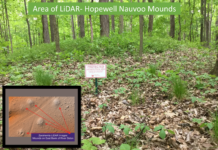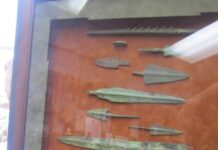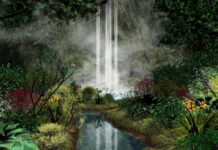Is it a stretch to say that Prophets and Archaeologists agree about the same thing? For example, Joseph Smith talks about mounds during Zion’s Camp March, and William Mills Archaeologists speaks about mounds in Ohio? Or Richards Moats Archaeoastronomer says Ancient Hebrews lived in Ohio, and Rod Meldrum says Ancient Nephites lived in Ohio.
For another example, the picture above to me should be called “the Nephite Interactive Sphere”, to Historians it is called “the Hopewell Interactive Sphere.” Who is correct? Who named this? Of course historians did, but why did they name it that? Why do I name it Nephite? We both have a different level of intelligence and bias. What is it really? “The Lord’s people Interactive Sphere”? Should it be called “the Native American Sphere?” Aren’t all people the Lord’s people? Aren’t we all saying the same thing?

See chart below as all the period’s of culture or time were called different things? You and I might call Clovis the period of Creation or the Archaic the time of Adam or the time of Woodland to be the Jaredite and Nephite time frame. Fort Ancient period is when the Mayans and Aztecs came to the Heartland and intermarried with those in the Heartland and later went back to Central America. The Mississippian and Historic periods were the Algonquin and Iroquois Native Americans of North America, or what do you think they are?
Do we have to argue? No!
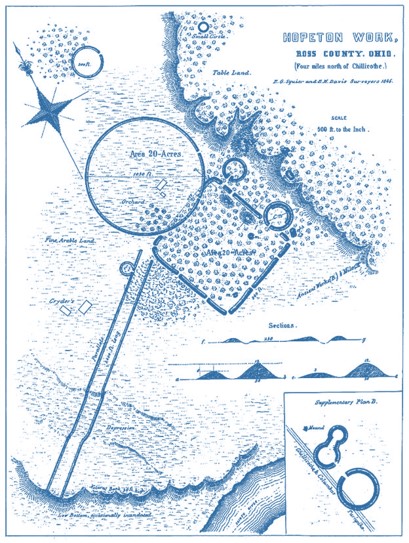
As you read this blog, ask yourself, “aren’t we all speaking about the same thing?” To some, Nephite and Jaredite are pretend names, and we know for sure Hopewell and Adena are Made-up Names! [Read Below] Can’t we all just get along and figure this out individually and then share what we have found? What is the truth? There is truth out there, so why don’t we quietly and patiently study and be prayerful on these various issues? Do we have to argue? No!
In this blog you will find various opinions on the same things. Prophets, Archaeologists, Saints, Historians, Ex-Mormons, and all various types of people speak about Mounds, and North American Natives, Lamanites, Nephites, Spheres, Cultures, Artifacts, and Complexes. Forget who is right or wrong, just read and be amazed at so many people speaking about the same thing. I choose to call it all, the Lord speaking from the Ground that the Book of Mormon happened in the Heartland of North America and The Book of Mormon is the word of God! What do you say?
Adena Name Came From Where?
“Adena burial mounds are common in the Ohio River Valley region. It was not, however, until 1901 that the first Adena mound was excavated for historical purposes by William C. Mills of the Ohio State Museum (Mills, 1902). This mound was on the estate of Thomas Worthington (Governor of Ohio, 1814- 18) in Ross County, a mile northwest of Chillicothe, Ohio. Governor Worthington gave the name “Adena” (probably from the Hebrew “Adinah”) Presumably he meant to imply “nothing lacking” or, freely translated, “paradise.” The name “Adena” was adopted by archeologists to refer to the prehistoric Indians who built such mounds…This area became one of the favored locations of these people between 800 B.C. and A.D. 800…” SMITHSONIAN INSTITUTION Volume 112 1960 Number 3441 WELCOME MOUND AND THE EFFIGY PIPES OF THE ADENA PEOPLE By Frank M. Setzler
Hopewell Name Came From Where?
Squier & Davis 1848 “New to Science The culture discovered at this site was new to the science of archeology in the late 1800’s. Newly described cultures field, which happened to be owned by a gentleman named Mordecai Hopewell at the time. Consequently, a remarkable American Indian culture, which is believed to have stretched from the Great Lakes to the Gulf of Mexico, is named after an otherwise obscure Chillicothe, [OH] land owner. The true tribal names of these people were lost over the millennia, but the ancient American Indians who built this sprawling structure were part of a cultural golden age that flourished in this region from A.D. 1 to 400. [I believe it was the Nephites]. The monumental architecture and artifacts of the Hopewell culture reflect a pinnacle of achievement in the fields of art, astronomy, mathematics and engineering, the likes of which was seldom seen again in eastern North America.” Squier & Davis
The subject of the disappearance of the Hopewell in 400 AD is well understood by members of The Church of Jesus Christ of Latter-day Saints. We believe the Hopewell are the same Nephites of the Book of Mormon who where destroyed about 400 AD. Some coincidences are just to wonderful, as we understand the lands of the Book of Mormon.
According to some historians, “little is known about why Hopewell mound-building ended, either about AD 200 in the lower Illinois Valley and about AD 350-400 in the Scioto river valley. There is no evidence of failure, no evidence of widespread diseases or heightened death rates: basically, the smaller Hopewell sites simply aggregated into larger communities, located away from the Hopewell heartland, and the valleys were largely abandoned.” Why Did the Hopewell People Build Enormous Mounds? John Weinstein The Field Museum by K. Kris Hirst Updated March 08, 2017
Your Challenge:
Just follow ONE paragraph of information in this blog, and research it yourself. Then pray about it. You may receive an answer that sheds more light on these subjects.
Do you feel the people discussed are Nephites, Hopewell, people of the Lord, Ancient Native Americans, or, doesn’t it matter?
Moroni said, “you may know the truth of all things.”
Hopewell Mound Group Chillicothe, Ohio

In 1891, Warren K. Moorehead was employed by Harvard University to excavate the site. His methods have been described euphemistically as “cavalier” by modern standards. Mosaics of colored sand, one represented a panther, were uncovered and then destroyed as his investigation cut through stratigraphy of the mounds. Mound 2 had 8,000 palm-sized discs of flint, about 5.4 metric tons (6 tons) uncovered.
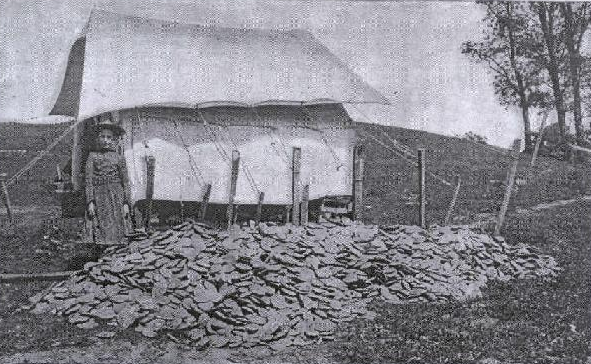
He must have been overwhelmed by the shear number of artifacts for a famous picture taken at the time (above) showed these discs recklessly piled outside one of his field camp tents. Mound 17 had 3,000 sheets of mica excavated, “enough to fill two barrels”. The same mound had 5,000 copper objects, of which Moorehead thought 4,000 were copper ear spools, 100 were breast plates, and another 120 were “cut into numerous designs”. He also found in Mound 17 by his estimates over 100,000 fresh water pearls from the various species mussels and clams that inhabit Ohio streams (they were at the time worth one million dollars).
Hopewell Double Burial Context and Interpretation:
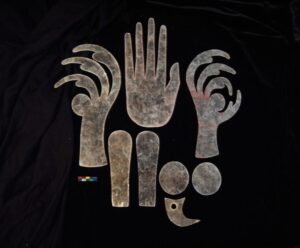 “Mica cutouts were produced by the Hopewell culture (100 BC-AD 400) which thrived in the American Midwest and southern Ohio more than two thousand years ago.
“Mica cutouts were produced by the Hopewell culture (100 BC-AD 400) which thrived in the American Midwest and southern Ohio more than two thousand years ago.
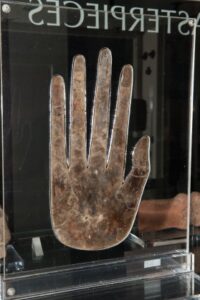
The artifacts that the replicas pictured left were based upon were excavated from a double burial in Mound 25 that was part of a complex of earthworks known as the Hopewell site. The site name honored Mordecai C. Hopewell who in the 1800s owned the farm which the 44.5 hectare (110 acre) mound complex was located. Since excavations on the Hopewell site produced artifacts that were previously unknown, the culture was also named after Hopewell. Nephite and Jaredite are factual names. Pictured is n actual mica artiifact hand

“Great Surprise”—Native Americans Have West Eurasian Origins
NOVEMBER 22, 2013
“Oldest human genome reveals less of an East Asian ancestry than thought.
Nearly one-third of Native American genes come from west Eurasian people linked to the Middle East and Europe, rather than entirely from East Asians as previously thought, according to a newly sequenced genome.
Based on the arm bone of a 24,000-year-old Siberian youth, the research could uncover new origins for America’s indigenous peoples, as well as stir up fresh debate on Native American identities, experts say.
The study authors believe the new study could also help resolve some long-standing puzzles on the peopling of the New World, which include genetic oddities and archaeological inconsistencies.
“These results were a great surprise to us,” said study co-author and ancient-DNA specialist Eske Willerslev, of the University of Copenhagen, Denmark.
“I hadn’t expected anything like this. A genome related to present-day western Eurasian populations and modern Native Americans as well was really puzzling in the beginning. How could this happen?” National Geographic 2013 Link here:
Hebrew and Hopewell DNA
Hebrew & Hopewell DNA “A lady by the name of Lisa Mills did her doctoral thesis on the Hopewell. She sampled 49 Hopewell burials from Mound City in Chillicothe, Ohio. They were originally excavated by Shetrone in the mid-20th century. Of the 49 she extracted Mt/DNA from 64% of them. What is significant is she found Haplogroup X in several remains. Haplogroup X is a marker that originated in Galilee. This in my opinion strongly suggests contact by the Hebrews with Hopewell. Richard D. Moats, Avocational Archaeologist, Archaeoastronomer
Temple Mound
There is a temple mound situated above the Ohio River near Cincinnati. “Fragments of burnt limestone may still be seen on the top. The mound is a rectangle two hundred and twenty-five feet long by one hundred and twenty feet broad, and seven feet high.” In contrast to the hewn stone buildings and altars of Mexico, the Ohio mound has the right dimensions to have accommodated a timber and burnt lime plaster (“cement”) building of the size and proportions of Solomon’s Temple.” J. P. Maclean, The Mound Builders – Archaeology of Butler County, Ohio, 1904, pp. 222-223.
Dr. Roger Kennedy
“Few realize that some of the oldest, largest and most complex structures of ancient archaeology were built of earth, clay, and stone right here in America, in the Ohio and Mississippi valleys. From 6,000 years ago until quite recently, North America was home to some of the most highly advanced and well-organized civilizations in the world – complete with cities, roads, and commerce.” Dr. Roger Kennedy, former director of the Smithsonian’s American History Museum.
Rod Meldrum
“The painting below by Kendra Burton titled, “Christ Visits the Nephites in North America”, shows Christ descending in a shaft of light to visit multitudes of Nephites who are streaming up a ramped earthen platform mound reminiscent of other earthen monuments made by the civilization now known as the Hopewell Mound Builders.
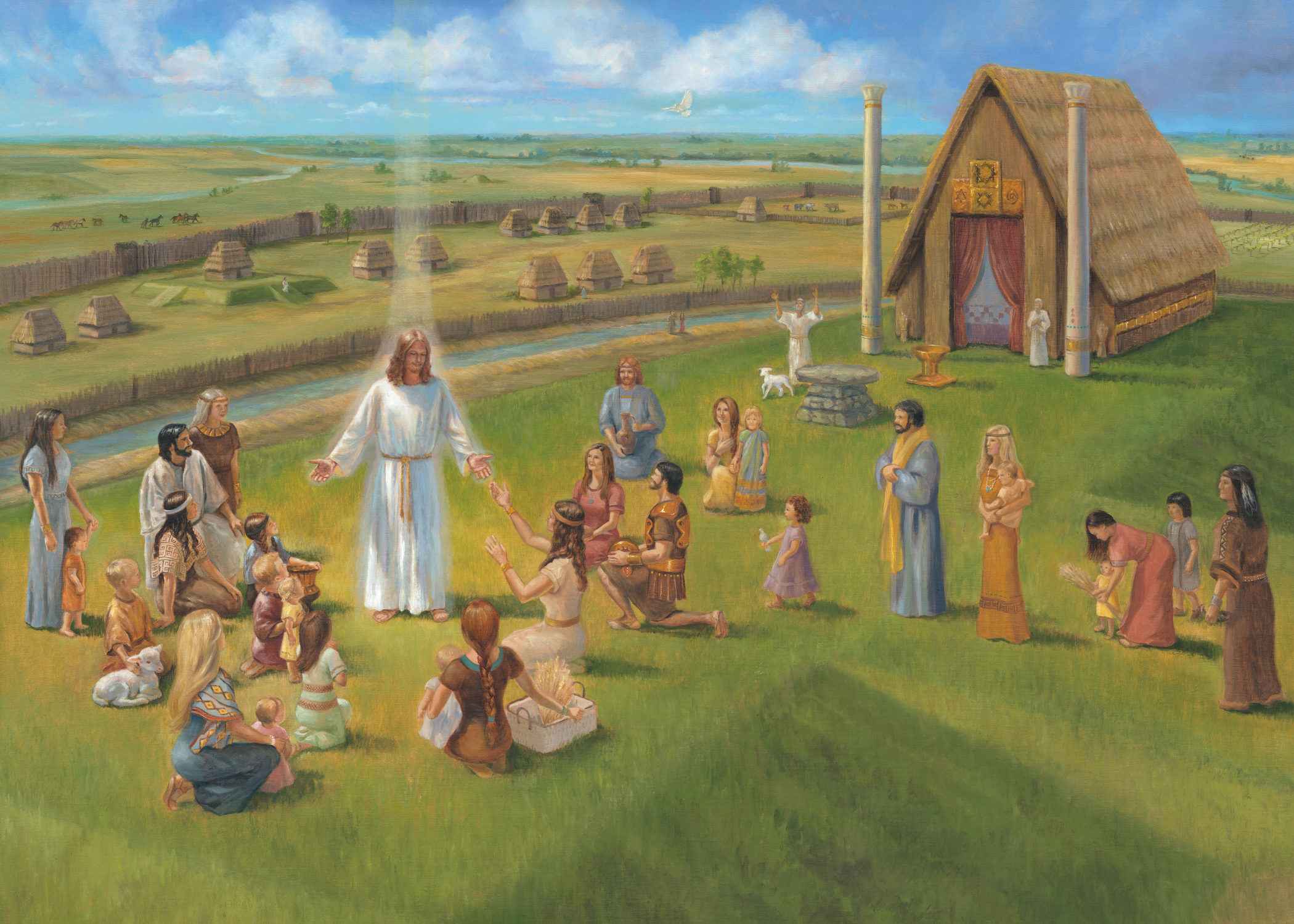
The background is a vast plain with interspersed massive grass-covered mounds, wooden homes with thatched roofs and hardwood forests, while the foreground shows a large wooden temple atop a monumental ramped earth structure. The scene is one that is true to the Book of Mormon record, without stone pyramids or thick jungle vegetation since nowhere in the text is there any mention of stone buildings, palm trees, monkeys or a tropical climate. The Heartland geography research has overwhelmingly demonstrated through Book of Mormon prophecies, Joseph Smith’s writings, DNA, archaeological, linguistic and cultural evidences that the most likely location for the setting of the Book of Mormon was in America’s Heartland. This painting is consistent with Joseph Smith’s known and historically documented statements and actions in such accounts as the those found in D&C 28, 30, and 32, the Wentworth Letter, the American Revivalist account, the Zelph accounts, Joseph’s hand-written letter to his wife while on Zion’s camp, and many additional sources.” Rod Meldrum, Author “Exploring the Book of Mormon in America’s Heartland”
Hugh Nibley
Contrasting the works of the mound builders with Mesoamerica stone ruins, Hugh Nibley observes: “A closer approximation to the Book of Mormon picture of Nephite culture is seen in the earth and palisade structures of the Hopewell and Adena culture areas than in the later stately piles of stone in Mesoamerica… Though such piles as the great pyramid-temple of Chichen Itza are surpassed by few buildings in the world in beauty of proportion and grandeur of conception, there is something disturbing about most of these overpowering ruins… The great monuments do not represent what the Nephites stood for; rather they stand for what their descendants, mixed with the blood of their brethren, descended to…” Hugh Nibley, The Prophetic Book of Mormon, pp. 272-273
Full Blog of Information Here Hopewell Culture: Mormonism & Double Burial Mica
Gregory L. Little
A list of earthworks was compiled to aid in the construction of archaeological maps for the general report and was then published in 1891 as Bulletin 12 of the Bureau of American Ethnology, “Catalogue of Prehistoric Works East of the Rocky Mountains” by Cyrus Thomas. This list, along with information from additional fieldwork, formed the basis for the construction of this map. The most common question that is asked about mounds is, “How many exist?” In the 1800’s the Smithsonian sponsored many expeditions to identify mound sites across America. A map (shown below) was produced by Cyrus Thomas in 1894 in a Bureau of Ethnology book. They found approximately 100,000 mound sites, many with complexes containing 2 to 100 mounds. The figure of 100,000 mounds once existing— based on Cyrus Thomas map revealing 100,000 sites—is often cited by others, but that estimate is far, far too low. After visiting several thousand mounds and reviewing the literature, I am fairly certain that over 1,000,000 mounds once existed and that perhaps 100,000 still exist. Oddly, some new mound sites are discovered each year by archaeological surveys in remote areas. But in truth, a large majority of America’s mounds have been completely destroyed by farming, construction, looting, and deliberate total excavations” – Gregory L. Little, Ed.D., The Illustrated Encyclopedia of Native American Mounds & Earthworks, Eagle Wing Books, Inc., Memphis, TN [2009].
Prophets Witness about North America
“The whole of our journey, in the midst of so large a company of social honest and sincere men, wandering over the plains of the Nephites, recounting occasionally the history of the Book of Mormon, roving over the mounds of that once beloved people of the Lord, picking up their skulls & their bones, as a proof of its divine authenticity… During our travels we visited several of the mounds which had been thrown up by the ancient inhabitants of this country-Nephites, Lamanites, etc.” Joseph Smith Papers Letter to Emma Smith, 4 June 1834 Page 56
Do You Believe Joseph Smith? I do!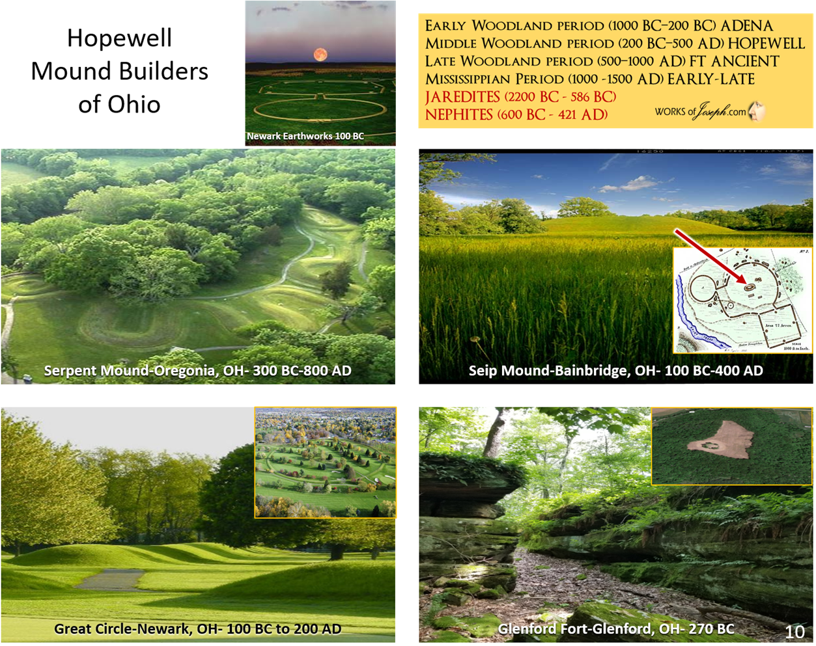
“…Here, between these hills, the entire power and national strength of both the Jaredites and Nephites were destroyed. By turning to the 529th and 530th pages of the Book of Mormon, you will read Mormon’s account of the last great struggle of his people, as they were encamped round this hill Cumorah. In this valley fell the remaining strength and pride of a once powerful people, the Nephites—once so highly favored of the Lord, but at that time in darkness, doomed to suffer extermination by the hand of their barbarous and uncivilized brethren. From the top of this hill, Mormon, with a few others, after the battle, gazed with horror upon the mangled remains of those who, the day before, were filled with anxiety, hope, or doubt.” Oliver Cowdery’s Letter VII Joseph Smith Papers “Letter VII,” LDS Messenger and Advocate, July 1835, 1:155–159 .
By the Book of Mormon was made known, that Zion, even the New Jerusalem, where all nations should come up to the house of the Lord, to worship the God of Jacob, in the last days, should be built on this continent; and thanks to him who rules all things after the counsel of his own will, and whose words never fail, the people of the United States, are already witnesses of the fulfilling of this prophecy, for they daily behold the children of God, gathering into his kingdom, ready to meet the Lord when he comes in his glory. The Savior said while ministering to the Nephites, that when the remnant of Joseph began to know that they were the covenant people of the Lord, the work had begun among all nations, and when we see Indians gathered home by the government, we must exclaim; the hand of the Lord is too plain in all this, not to be noticed, and the agitation of the whole globe is too evident, not to cause wonder. While the rumors of war, and war, shake one kingdom to the centre [center], the pestilence and its horrors spread despair and death in another. All flesh is grass, and when the meek and the humble wish to be saved, and learn the will of the Lord, whiel [while] they look upon the events, convulsions, and signs of the times, witnessing in a language which he that runs may read, that the end is nigh at hand, even at the doors, they are ready to come out of Babylon and shun her plagues. Men generally believe upon testimony, and the rule is good. Now, as to the evidence of the truth of the bible, we have no eye witnesses to prove it, for they have been dead many hundred years, and the fashion of saying you believe it is true, because your father said so, will not amount to proof, but the testimony of the Spirit of God, is, that it is true. The book of Mormon, besides the evidence of the Holy Spirit, showing that God is the same yesterday, today, and forever, has the living witnesses to bear testimony that it is true:-“ THE EVENING AND THE MORNING STAR Vol. I. Independence, MO January 1833, No. 8. Editor Oliver Cowdery
Do You Believe Oliver Cowdery? I do!
Mounds of Human Skeletons
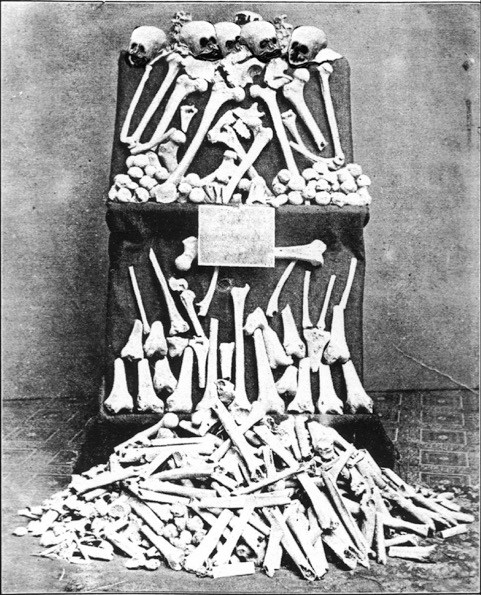
Mounds of Human Skeletons Found near Lake Erie and Lake Ontario
“… The purpose of the mounds of New York, so far as can be determined, seem uniformly to have been those of sepulture. They generally occur upon commanding or remarkable positions. Most of them have been excavated, under impulse of an idle curiosity, or have had their contents scattered by “money-diggers,” a ghostly race, of which, singularly enough, even at this day, representatives may be found in almost every village. I was fortunate enough to discover one upon Tonawanda Island, in Niagara River, which had escaped their midnight attentions. It was originally about fifteen feet in height. At the base appeared to have been a circle of stones, perhaps ten feet in diameter, within which were several small heaps of bones, each comprising three or four skeletons.
The bones are of individuals of all ages, and had evidently been deposited after the removal of the flesh. Traces of fire were to be discovered upon the stones. Some chippings of flint and broken arrow-points, as also some fragments of deers’ horns, which appeared to have been worked into form, were found among the bones. The skulls had been crushed by the superincumbent earth. The mounds which formerly existed in Erie, Genesee, Monroe, Livingston, St. Lawrence, Oswego, Chenango, and Delaware counties, all appear to have contained human bones, in greater or less quantities, deposited promiscuously, and embracing the skeletons of individuals of all ages and both sexes. …They were sometimes heaped together so as to constitute mounds; at others placed in pits or trenches dug in the earth … or deposited in caverns, either promiscuously or with regularity.” (E. G. Squier, ABORIGINAL MONUMENTS OF THE STATE OF NEW YORK, Originally published in the Smithsonian Contributions to Knowledge, Volume 2, 1849, Ch. IV, “MOUNDS, BONE-HEAPS, ETC.”, pg. 67)
“In Greene township, about two miles below the village, was formerly a mound of some interest … An examination of the mound was made in 1829 by excavation. Great numbers of human bones were found; and beneath them, at a great depth, others were found which evidently had been burned, No conjecture could be formed of the number of bodies deposited here. The skeletons were found lying without order, and so much decayed as to crumble on exposure. At one point in the mound a large number, of perhaps two hundred, arrow-heads were discovered, collected in a heap. .. another pile of sixty or more, was found in another place, in the same mound; also a silver band or ring, about two inches in diameter, wide but thin, and with what appeared to be the remains of a reed pipe.
A number of stone gouges or chisels, of different shapes, and a piece of mica, cut in the form of a heart, the border much decayed and the laminae separated, were also discovered. It may be mentioned here, that the character of the lower deposit, and also some of the relics, coincide with some of those found in the mounds of Mississippi Valley. The ancient mound-builders often burned their dead. The upper and principal collection of bones had probably a comparatively late date, as is shown by the silver bracelet, which, it is presumed, although not so expressly stated, was found with this deposit.” (E. G. Squier, ABORIGINAL MONUMENTS OF THE STATE OF NEW YORK, Volume 2, 1849, “CHENANGO COUNTY”, pg. 34; see also Joseph Smith – History 1:56)
“In cultivating the area, many fragments of human bones, some of them burned, have been observed, – suggesting the possibility that the ancient village was destroyed by enemies, and that these are the bones of its occupants who fell in defense of their kindred, and were burned in the fires which consumed their lodges.” (E. G. Squier, ABORIGINAL MONUMENTS OF THE STATE OF NEW YORK, Volume 2, 1849, “JEFFERSON COUNTY – EARTH-WORKS, ETC.”, pg. 20)
ABORIGINAL MONUMENTS OF THE STATE OF NEW YORK Surveyed by E. G. Squier LDS Scripture specifically identifies native people living in the western wilderness near Lake Erie, as “Lamanites” – descendants of Book of Mormon people. (LDS Doctrine and Covenants 32:1-2) In the early days of the Church, missionaries were sent to these natives, “remnants of the house of Joseph … residing in the west”, to give them glad tidings of the Book of Mormon. (History of the Church 1:118-120) Joseph Smith had published the Book of Mormon in 1830 in Palmyra, New York. It tells of migrations of people to America before Columbus.
“Smith became the founder of the only world religion to be based in American archeology. Because the American Indians have never sought to evangelize Europeans or Africans, Mormonism is also the only world religion to place American Indian experience at the center of its creed.” “It is true to this day that the Mormon church, the largest denomination to accept the Lost Tribes view of Indian origins, has been consistently interested in evangelistic—that is respectful—relations with Native Americans.” 1491 New Revelations of the Americas Before Columbus, Charles C. Mann and information provided by Wayne May Ancient American Magazine

Squier & Davis, c.1848 Two thousand years ago, people of an advanced culture gathered here [Map Above Chillicothe, OH] to conduct religious rituals and ceremonies related to their society. At this site, they built an enormous earthwork complex spanning about 130 acres. An earthen wall extended for over two miles, surrounding an immense sacred space that included 29 burial mounds. Astounding quantities of finely crafted art made of exotic materials were buried here as part of elaborate mortuary ceremonies.
Hopewell Mound Group Mound 25, [spoken about earlier] the largest in the Hopewell site enclosure, was composed of the Central Mound and two side mounds that over time, due to additional burials, merged to become one conjoined mound 9 m (30 ft) high and 152 m (500 ft) long. There were a total of 69 copper and (meteoritic) iron celts and 92 copper breastplates found in all the features of this mound. The significance of the better known mica hand placed between the skulls of the double burial and two mica eagle talons which were placed on each chest is not understood. Evidence of incising has been found on one of the mica talons. No pigment is observed on the surface of these artifacts as has been found on painted mica artifacts. The burial also had smaller two mica circular discs, a pierced claw and two other mica geometric forms placed at their waist. The photograph (bottom) has the mica replicas positioned as they were found in the Hopewell grave (relative distances between replicas not accurate). The geographical origins of grave goods from this and other excavations indicated the Hopewell culture had trade sophisticated trade networks extending to the Gulf of Mexico (marine shells), Rocky Mountains (obsidian), and Michigan (native copper). North Carolina is one source of mica where one pre-Columbian mine was reported to have blunt excavation makings on its wall characteristic of stone tools. Cause for the Hopewell culture decline about AD 400 is not known.” Jack Corbo Cleveland Ohio [See Hopewell Cultural Sphere Map at the top of this page]

EVIDENCES IN PROOF OF THE BOOK OF MORMON
By Charles Thompson, minister of the gospel; published at Batavia, N.Y.
WE HAVE LAYING BEFORE US,” wrote Ebenezer Robinson, editor of the Times and Seasons for January 1, 1842, “a neat little work of 256 pages, 32 mo. entitled ‘Evidences in proof of the Book of Mormon’ &c. By Charles Thompson, minister of the gospel; published at Batavia, N. Y. We are much pleased with the spirit manifested by the writer, and feel to commend him in his laudable undertaking.” Indeed, four and a half pages (more than a quarter of this issue) were devoted to extracts from Thompson’s proofs and comments. (Times and Seasons 3:5; pp. 640-44)
 Such a work was needed badly. Thompson took on the project with apologies for his personal limitations, hoping to benefit “the young Elders and Priests who are just commencing in their ministry,” as well as new converts and an uninformed public (Preface, p. [3]). Among the “young” missionaries was Thompson himself, only twenty-seven years of age. He had joined the Church at age 21, was soon appointed a seventy, and in 1838 joined the Kirtland Camp to Far West, Missouri . . .
Such a work was needed badly. Thompson took on the project with apologies for his personal limitations, hoping to benefit “the young Elders and Priests who are just commencing in their ministry,” as well as new converts and an uninformed public (Preface, p. [3]). Among the “young” missionaries was Thompson himself, only twenty-seven years of age. He had joined the Church at age 21, was soon appointed a seventy, and in 1838 joined the Kirtland Camp to Far West, Missouri . . .
 Charles Thompson’s 1838 signature on the Kirtland Camp constitution as reproduced in Milton V. Backman, The Heavens Resound; A History of the Latter-day Saints in Ohio 1830-1838 (Salt Lake City, 1983), p. 390.
Charles Thompson’s 1838 signature on the Kirtland Camp constitution as reproduced in Milton V. Backman, The Heavens Resound; A History of the Latter-day Saints in Ohio 1830-1838 (Salt Lake City, 1983), p. 390.
Charles Thompson said, “Book of Mormon, page 479, 2nd Ed., “And it came to pass that the ninety and third year (of the reign of the Judges over the people of Nephi) did also pass away in peace, save it was for the Gadianton robbers, who dwelt upon the Mountains, who did infest the land; for so strong were their holds and their secret places, that the people could not overpower them; therefore they did commit many murders, and did so much slaughter among the people.” Again; Book of Mormon, page 481, “And it came to pass in the commencement of the fourteenth year, (form [from] the time the sign was given of the birth of Christ,) the war between the robbers and the people of Nephi did continue, and did become exceeding sore; nevertheless the people of Nephi did gain some advantage of the robbers, insomuch [inasmuch] that they did drive them back out of their land into the mountains and into their secret places.” Again; Book of Mormon, page 485, 2nd Ed., “But it came to pass that in the latter end of the eighteenth year, those armies of robbers had prepared for battle and began to come down and to sally forth from the hills, and out of the mountains and the wilderness, and their strong holds and their secret places, and began to take possession of the lands.” And on the 487 and 488 pages, we are informed how these robbers were finally destroyed; it was by a stratagem. A part of the Nephite armies getting between the robbers and their secret places and strong holds, by which they were cut off in their retreat.

This again, is evidence that the Book of Mormon is true, and that this band of robbers were the constructors of this strong hold and these secret rooms which Mr. Furguson has described; for mark! this discovery was not made untill [until] two years after the Book of Mormon was published, consequently the writer of the Book of Mormon could not have written this tale concerning the robbers, to account for the construction of those caverns, for it was not known that there was such a place in existence, until after the book was written and published. And thus we have abundance of proof from recent discoveries, American Antiquities and prophecy, that the history contained in the Book of Mormon is true.
Again; this history informs us that about four hundred years after Christ, this nation of Nephites were brought down and destroyed by the Lamanites; and this because they became proud and lifted up, practising [practicing] all manner of wickedness and abominations, and they refused to repent and turn again unto God; therefore because they were more wicked than the Lamanites, God stirred up the Lamanites to camp against them round about, and to raise forts against them with a mount, and thus they were brought down. But just before their final overthrow, a man by the name of Mormon took their record containing their history and sacred writings, from the time they left Jerusalem, (the city where David dwelt,) unto his days, and made an abridgement [abridgment] therefrom, and engraved it upon plates which he made out of ore.
These plates, after Mormon’s death, fell into the hands of Moroni, his son, who survived the entire destruction of the Nephites, finished the record, and deposited it in a stone box in the earth, that it might not be destroyed; to come forth in due time for a sign to Israel, that the time of their redemption had come. And also, in connection with the Bible, to be set up as an ensign for the nations; and thus, this nation of Nephites possessing the light of God’s revelation, which constituted them Ariel, or Lion of God, and being “of the city where David dwelt,” (that is, having come out from Jerusalem,) was brought down and their words having been written and hid up in the earth and come forth again out of the earth, they “speak out of the ground and their voice whispers out of the dust.”
This account also agrees with the Indian traditions which I have quoted in a former part of this work. It says, that their forefathers were once in possession of a sacred Book, which was handed down from generation to generation, and at last hid in the earth; but these oracles are to be restored to them again and then they shall triumph over their enemies and regain their ancient country.” By Charles Thompson, minister of the gospel; published at Batavia, N.Y Entire blog here



